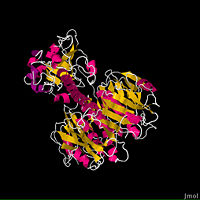User:Caitlin Bell/Sandbox 1
From Proteopedia
Contents |
CHOLERA TOXIN
Introduction
The cholera toxin is released by the pathogen Vibrio cholerae during colonization of the small intestine. Vibrio organisms are mainly found in saltwater, but there some that live in freshwater. These organisms use glucose for energy, and they use flagella for locomotion.
Cholera is widespread in mainly poverty-stricken areas where food and water environments are unsanitary. After ingestion of Vibrio cholerae, which typically is a result of feces particles in water or food, the cholera toxin is secreted and infects the small intestines, leading to the Cholera disease. Excessive diarrhea and vomiting ensues soon after ingestion, and death can occur within a few hours. Cholera is prevalent in Africa, Asia, and Latin America, leading to 3-5 million cases and 100,000-200,000 deaths every year.
|
Structure
The fundamental structure of the cholera toxin is rather basic. It is a complex of six proteins that are structured into two subunits: A and B. The A subunit contains only one protein and is the only toxic part of the protein. The B subunit contains five proteins and is non-toxic.
The is the most destructive part of the cholera toxin. It can be further broken down into two chains: A1 and A2. These chains are held together through a peptide bond and single disulfide bond. The is entirely non-polar, which allows it to pass through the intestinal membrane and into the cell. The A1 chain has a for NAD+, and when bound, begins the downstream events that ultimately leads to the Cholera disease. The 's main function is to connect the A1 chain to the B subunit through the B subunit's cylindric pore.
The ’s only function is to allow the cholera toxin to enter the intestinal epithelial cells through endocytosis. It accomplishes this from its unique structure. The B subunit contains five alpha helix proteins that are connected together to form a pentagon. Each alpha helix contains a single binding site for the intestinal lining, which is called its (monosialoganglioside binding site).
Mechanism of Action
The mechanism of action of the cholera toxin can be broken down into three simple stages: entry of the toxin into the cell, activation of the G protein through its catalytic functions, and efflux of ions.
First, after ingestion of Vibrio cholerae, the cholera toxin is secreted in the intestines. Once inside, the B subunit binds to the intestinal wall through its . The cholera toxin is then engulfed by the intestinal epithelial cell through endocytosis, and immediately following, the A subunit is cleaved at its disulfide bond to release the A1 chain.
Second, after the A1 chain is released inside the intestinal cell, it binds NAD+ at its . Once bound, the removes an ADP-ribose from it, and the A1 chain proceeds to transfer this to a stimulatory G protein. This transfer is called an ADP-ribosylation reaction.
Third, once the stimulatory G protein is bound to an ADP-ribose, it is permanently active. This means that it is unable to hydrolyze its GTP, which would normally allow the protein to “switch off”. Thus, the stimulatory G protein continually activates adenylyl cyclase, which leads to a constant production of cAMP. Consequently, cAMP activates Protein Kinase A, which activates the CFTR-regulated Cl- channel. Constant activation of this ion channel results in an enormous efflux of ions and water from the cell to the interstitial lumen, which is representative of the symptomatic excessive diarrhea in Cholera.

